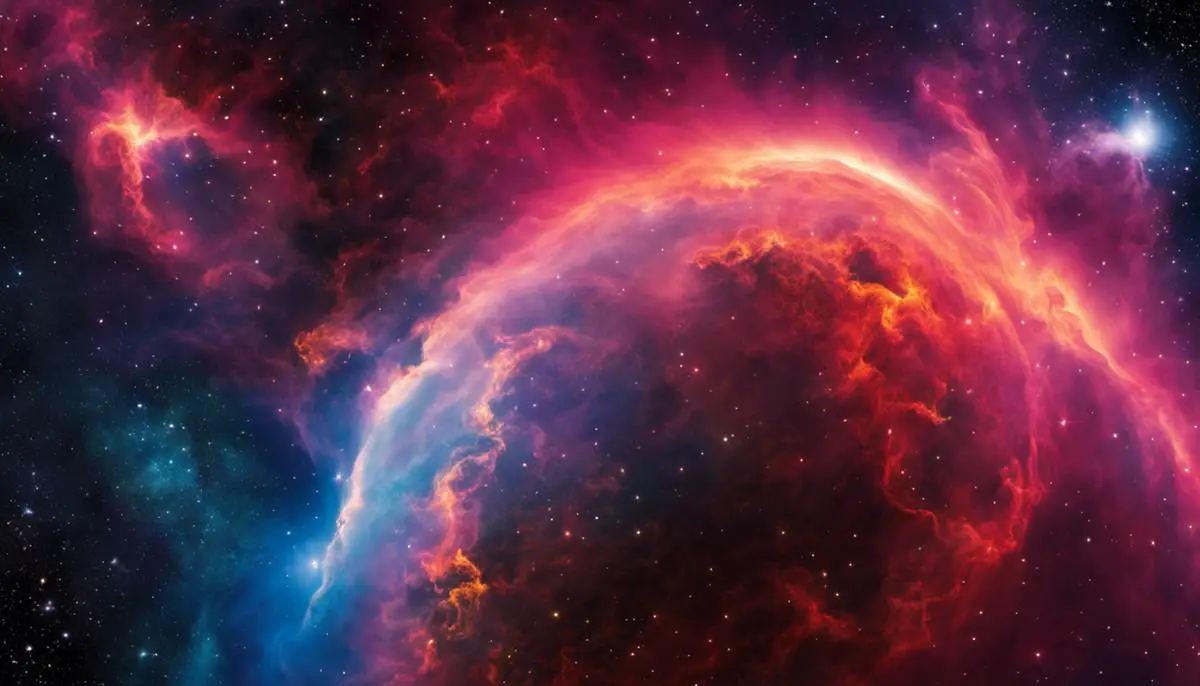Embarking on a remarkable journey across the cosmos, our quest for understanding takes us to the intriguing world of space nebulae. These celestial objects serve as cosmic nurseries, spaces of breathtaking beauty, and provide essential contributions to our comprehension of the universe around us. Our exploration will take us to the depths of two unique nebulae – the Horsehead Nebula and the Flame Nebula, both of which captivate scientists with their distinctive characteristics and mysterious processes. While offering a grasp of the basic concepts of nebulae, this journey aims to provide a comparative study of these two fascinating stellar structures, shedding light on what makes them unique and their intriguing commonalities.
Understanding Space Nebulas
Understanding Space Nebulae
A nebula is a giant cloud of dust and gas in space. Some nebulae (the plural of nebula) come from the gas and dust thrown out by the explosion of a dying star, such as a supernova. Other nebulae are regions where new stars are beginning to form. Nebulae are made of dust, hydrogen and helium gas, and plasma. They are often vast in size, some measuring dozens to hundreds of light-years in diameter.
Description and Formation of Horsehead Nebula
Situated approximately 1,500 light-years away in the constellation of Orion, the Horsehead Nebula, also known as Barnard 33, is one of the most identifiable nebulae because of the twisted central pillar of dust and gas appearing as a horse’s head when observed from Earth. This cosmic formation involves a dusty nebula tucked away in one corner, under the gaze of the bright star Sigma Orionis.
The Horsehead Nebula was originally a cloud of cool gas and dust, collapsed under gravity, and is now actively forming new stars. However, the intense ultraviolet radiation from Sigma Orionis is heating up the upper layers of the nebula, causing the gas to glow and yielding the iconic imagery observed.
Description and Formation of Flame Nebula
Just south of the Horsehead Nebula, we encounter another famous nebula— the Flame Nebula, also known as NGC 2024. Residing nearly 1,400 light-years away, the Flame Nebula is an active star-forming nebula, renowned for its quality of being an emission nebula, meaning it emits light from hot, ionized gases.
This nebula’s formation is also driven by a principal star known as Alnitak. The flame-like appearance is due to a dense, dark dust lane that runs through the centre of the nebula, obscuring light from the energetic processes happening behind the dust. The wider nebula is illuminated by the intense ultraviolet rays of Alnitak exciting the hydrogen gas within the nebula, causing it to emit the reddish light that gives the nebula its fiery appearance.
Both the Horsehead and Flame Nebulas are intriguing parts of the Orion Molecular Cloud Complex, a rich and diverse astronomical region teeming with nebulae, star clusters, and other fascinating celestial objects. Each of these nebulae, while part of the same complex, presents a unique phenomenon, being the result of different formation processes, possessing distinct forms, and influenced by different primary stars.
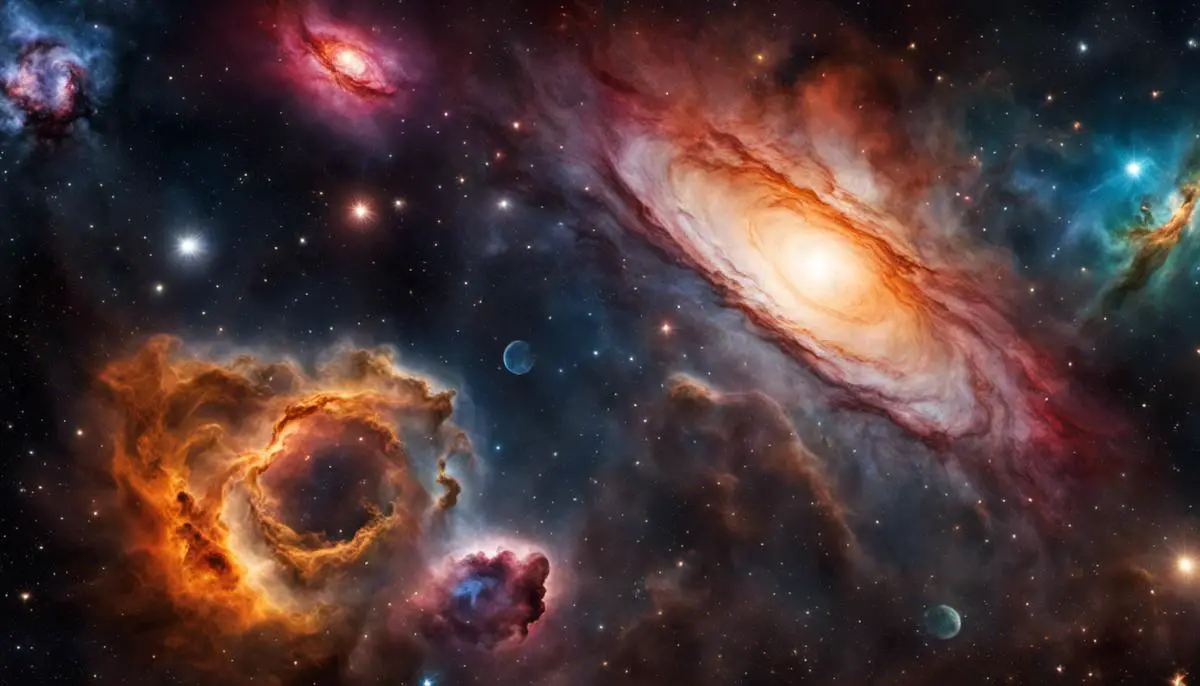
Experiencing the Horsehead Nebula
An Exploration of the Horsehead Nebula
Renowned and easily recognized, the Horsehead Nebula, or Barnard 33, paints a striking figure in the Orion constellation. Positioned about 1,500 light-years away from our planet, this nebula claims its place in the vast Orion Molecular Cloud Complex, a group that includes other prominent nebulae such as the Orion and Flame Nebulas.
The nebula’s moniker ‘Horsehead’ is a testament to the unique shape its constellation of gases and dust particles form, an image shaped by wind forces and stellar radiation. This cloud bears a stark silhouette against the bright, red emission nebula in the background, forming a spectacle that enraptures both casual stargazers and seasoned astrophotographers alike.
Behind its stunning exterior, the Horsehead Nebula is a hotbed of universal processes common to many nebulae. Often referred to as stellar nurseries, nebulae are sites where new stars spring to life from dense clouds of gas and dust. Much like the iconic Pillars of Creation, this nebula is an active region of star formation, with its internal environment continuously transformed by stellar winds and gravitational forces.
Adding to its intrigue is the notable presence of a dense molecule named C2H. Found in its highest concentration here, this molecule presents an intriguing point of interest for astrophysicists and researchers studying the Horsehead Nebula.
Contrasting Cosmic Wonders: Horsehead Nebula and Flame Nebula
The Horsehead Nebula and the Flame Nebula are two distinctive astronomical features, each carrying its unique set of characteristics. Located in the vast expanse of the Orion Molecular Cloud Complex, these nebulae bring a cosmic allure to Orion’s Belt.
The Flame Nebula, or NGC 2024, resides near Alnitak, the easternmost star of Orion’s Belt. Positioned closer to us than the Horsehead Nebula, it stands roughly 1,350 light-years away from Earth.
The Flame Nebula lives true to its name, with vibrant hues that mimic the radiance of a raging inferno. This glow comes from ionized hydrogen gas, stirred to life by the luminosity of the nearby star Alnitak. Its fiery allure makes it a favored subject for both budding and seasoned astronomers alike.
The Horsehead and Flame Nebulae, despite stark contrasts in appearance, distances, and resident elements, both play critical roles in broadening our cosmological understanding. Each offers a unique perspective into the intricate processes of stellar formation and the complex behavior of the interstellar medium.
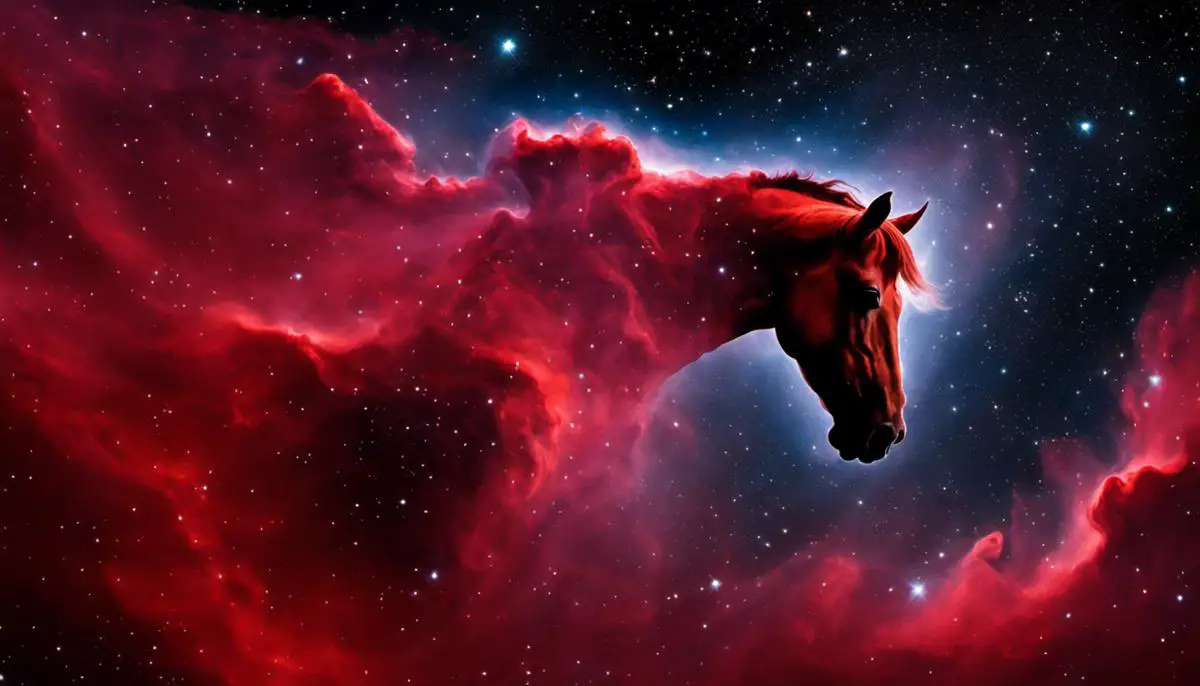
Discovering the Flame Nebula
Flame Nebula: A Cosmic Illumination
Taking a closer look at the Flame Nebula, or NGC 2024, one finds it located in the constellation of Orion, about 1,400 light years from Earth. Its proximity to Alnitak, the Orion’s Belt’s easternmost star, offers a spectacular sight. Alnitak, a bright blue supergiant, gives life to the glowing gas and dust enveloping the Flame Nebula.
The Flame Nebula boasts of a complex and captivating structure. Dark lanes artistically streaked across the glowing gas are dense regions laden with dust. These regions become areas of intense stellar creation, a process offering fascinating insights into the life cycle of stars and capturing researchers’ intense curiosity.
Interestingly, these dark lanes not only underscore the Flame Nebula’s namesake appearance but also shed light on the orientation of interstellar magnetic fields. Uncovering the patterns of these fields could potentially unlock valuable understanding of the galactic evolution process.
The Horsehead Nebula: Equestrian Marvel in the Cosmos
Contrasting the Flame Nebula is the Horsehead Nebula, otherwise known as Barnard 33. It resides in the same constellation as the Flame Nebula, Orion, yet forms a starkly different feature—the nebula exhibits a somewhat horse-shaped silhouette against a soft, glowing background. This iconic shape is a product of dense dust and gas obscuring the light emitted by the ionized gas behind it.
The Horsehead Nebula stands as a remarkable example of a dark nebula. Unlike the Flame Nebula, it’s not the glow from elements in high-energy states that draws attention to the Horsehead Nebula—rather, it’s the lack of glow, the stark contrast against the bright curtain of the nebula IC 434.
The Horsehead Nebula, much like the Flame Nebula, is an interest to the scientific community due to the processes occurring beneath its dark shroud. The dark regions of the nebula contain the necessary conditions for stars and perhaps even planetary systems to form, inviting researchers to explore its mysteries and learn more about cosmic genesis.
A Journey from Flame to Horsehead
When discussing the Flame Nebula and the Horsehead Nebula, the intrigue lies less in their distinct appearances and more in their unique functionalities and elemental processes. Both nebulae are akin to cosmic nurseries, birthing new stars from the remnants of their celestial forebears. The Flame Nebula highlights the ripple effect triggered when fiery, young stars kindle surrounding gases. Conversely, the Horsehead Nebula offers a pre-ignition glimpse into the complexities of the universe: shadowy, concentrated and brimming with potential.
Investigating both the Flame and Horsehead Nebulae can be perceived as probing into diverse stages of stellar genesis. The myriad forms and intriguing variances of these nebulae captivate astrophysicists and astronomy enthusiasts, providing valuable insight into the history of our universe, its prospective future, and its awe-inspiring capacity for creation, evolution, and transformation.
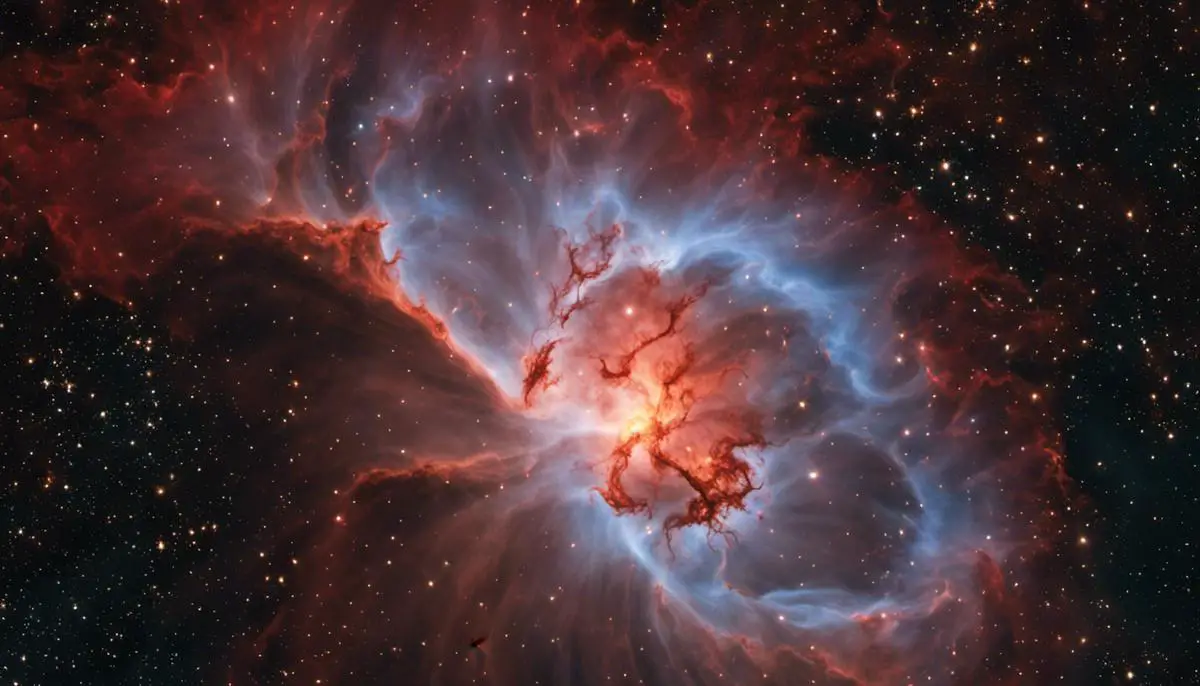
Horsehead Nebula vs. Flame Nebula: Differences and Similarities
Delving into the Horsehead Nebula
Regarded officially as Barnard 33, the Horsehead Nebula is an icy, obscure, and cogent cloud of interstellar gas, positioned in the Orion Constellation, roughly 1,500 light-years distant from our planet. Its iconic horsehead-like silhouette is shaped by dust obstructing the radiant gas behind it. This nebula predominantly comprises dense, cool gases and dust. Moreover, it houses sizable molecules such as ethyl alcohol, methyl alcohol, and acetylene, which are speculated to be the progenitors of life.
Interestingly, the Horsehead Nebula isn’t a thriving hub for star birth, owing to its icy and dense conditions. But, there might be a shift in this celestial trend as adjacent, heated and youthful stars – belonging to the Sigma Orionis star cluster – gradually shed their energy and warmth. This energy influx can permeate the nebula, stimulating gas accumulation which can eventually pave the way for new star formation.
Introduction to the Flame Nebula
The Flame Nebula (NGC 2024) is another remarkable nebula situated in the constellation of Orion, and, like the Horsehead Nebula, it is about 1,500 light-years away from Earth. This nebula gets its fiery moniker due to the gas and dust providing a radiant, flame-like appearance. As opposed to the Horsehead Nebula, The Flame Nebula presents an environment abundant with star birth, attributed to its dense concentration of hot, young stars.
The composition of the Flame Nebula primarily includes ionized hydrogen gas, resulting in the red-orange flames that give this nebula its name. The youngest stars found in Flame Nebula are often shrouded by dust clouds, making them difficult to observe with traditional optical telescopes.
Comparisons and Contrasts between Horsehead and Flame Nebulae
Both the Horsehead Nebula and Flame Nebula are situated in the Orion constellation and are approximately the same distance from Earth. They both are composed of gas and dust and are notable for their distinctive appearances and the processes occurring within them.
However, they differ significantly in a number of aspects. The Horsehead Nebula, also known as a dark nebula due to its dense and opaque cloud of dust, is cold and tends to obstruct star formation. Its black silhouette against a backdrop of glowing gas provides its unique horsehead shape.
On the other hand, the Flame Nebula is an emission nebula, consisting of ionized gases that emit light of various colors. Its name comes from the bright, flame-like appearance of these ionized gases. Unlike the Horsehead Nebula, the Flame Nebula is associated with a profusion of star birth and possesses a high concentration of young stars.
These differences and similarities between the Horsehead Nebula and Flame Nebula provide an intriguing insight into the diverse nature of nebulae and their contributions to star formation and the composition of our universe.
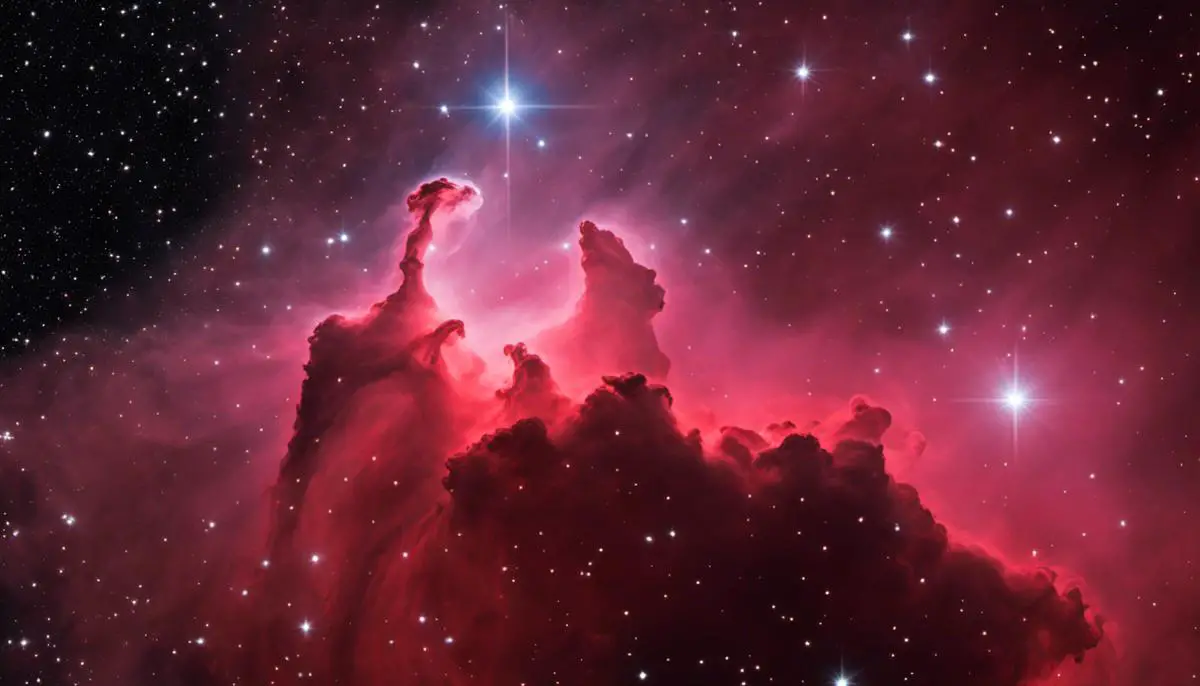
The whirlwind tour of these celestial spectacles concludes by having garnered a deeper understanding of the universe’s creative canvas. The intricacies of the Horsehead Nebula and Flame Nebula are captivating stories of cosmic processes, unique shapes, and locations. Weaving together their individual narratives and comparisons have offered insights into their unique processes and shared traits. With every observation, analysis, and discovery about these nebulae, we are one step closer to unraveling the broader mysteries of the cosmos, a journey that remains as enchanting and astounding as ever. As you glance up at the night sky, remember that every point of light holds a story, a universe within itself, waiting to be discovered.
![]()
